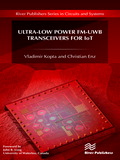|
| ||||||||||||
The IEEE Electron Devices Technology and Manufacturing (EDTM) Conference 2021 is a four-day meeting to be held in Chengdu, China, during March 9th to 12th, 2021. Sponsored by IEEE Electron Devices Society (EDS), EDTM2021 is a premier conference, providing a unique forum for discussions on a broad range of device/manufacturing-related topics. EDTM2021 starts on Tuesday, March 9, 2021 with Tutorial & Short Courses, followed by three days of Plenary talks and parallel Oral sessions. Joint Poster sessions and Exhibition will be held on the same site. EDTM2021 Theme: Intelligent Technologies for Smart and Connected Life. ▪ Technical Areas EDTM2021 solicits papers in all areas of electron devices, including materials, processes, devices, packaging, modeling, reliability, manufacturing and yield, tools, testing, and any emerging device technologies. EDTM2021 cordially invites authors to submit your papers. Please refer to the EDTM2021 website for more details, or clink links below: EDTM2021 website: https://ewh.ieee.org/conf/edtm/2021/ ▪ Sponsorship & Exhibition EDTM2021 also warmly invites sponsors and exhibitors to participate in and support the conference where you can showcase your new technologies and products to attendees from around the world. ▪ Awards EDTM2021 will select Best Paper Award, Best Student Paper Award and Best Poster Paper Award. ▪ Publications All selected and presented papers will be included in the EDTM2021 Proceedings that will be published at the IEEE Xplore. Selected papers will be invited to submit the extended manuscripts that will be reviewed for possible publication in the IEEE Journals of Electron Devices Society (J-EDS), which is an Open Access journal. ▪ Important Dates
▪ Location Chengdu, located in southwest of China, is not just the home for Grand Pandas. An emerging technology and business hub full of hi-tech companies from around the world, it is also a trendy city where you will find everything that you could imagine for you to enjoy your leisure time, from the famous Sichuan food to mind-soothing teas to natural scenics to historical wonders. The wonderful city is just an easy flight away from many places around the Globe. ▪ Contacts General Chair: General Co-Chair: TPC Chair: TPC Co-Chair: COVID-19 Watch: Chengdu remains safe. EDTM2021 is planned as an in-person/on-site event. Meanwhile, we are closely monitoring the development of global COVID-19 outbreak. A contingency plan will allow virtual presentations and participation for those with travel restrictions and concerns. Both safety and participation experiences will be ensured for EDTM2021. EDTM2021 website: https://ewh.ieee.org/conf/edtm/2021/ | ||||||||||||
|
|






 Add Event to Calendar
Add Event to Calendar 
